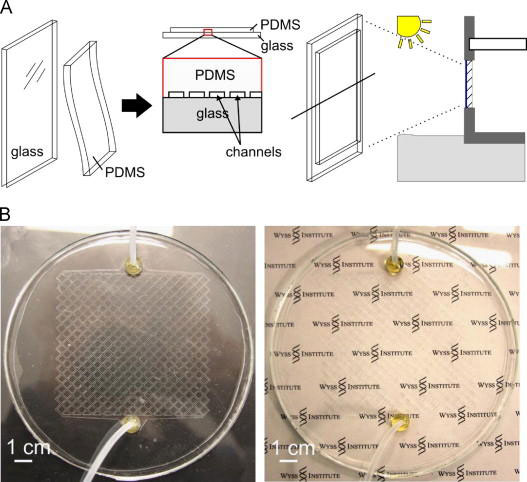| Aug 02, 2013 |
Bio-inspired design may lead to more energy efficient windows
|
|
(Nanowerk News) University of Toronto Engineering professor Ben Hatton (MSE) is turning to nature to find a way to make windows more energy efficient.
|
|
In a recent article in Solar Energy Materials & Solar Cells ("An artificial vasculature for adaptive thermal control of windows"), Hatton and colleagues at Harvard University describe a novel process to cut down on heat loss during the winter and keep buildings cool during the summer. Their "bio-inspired approach to thermal control for cooling (or heating) building window surfaces" calls for attaching optically clear, flexible elastomer sheets, bonded to regular glass window panes.
|
 |
| A. Schematic of the composite window structure. B. The artificial vascular network layer. (Image courtesy of University of Toronto Faculty of Applied Science & Engineering)
|
|
The elastomer sheets, made from polydimethylsiloxane (PDMS) have channels running through them through which room temperature water flows. The technique has resulted in 7 to 9 degrees of cooling in laboratory experiments and is effective both at small and large scales, Hatton and his colleagues said.
|
|
"Our results show that an artificial vascular network within a transparent layer, composed of channels on the micrometer to millimeter scale, and extending over the surface of a window, offers an additional and novel cooling mechanism for building windows and a new thermal control tool for building design," he said.
|
|
Hatton noted that windows account for about 40 per cent of building energy costs. To find a solution to the problem, he turned to nature. "In contrast to man-made thermal control systems, living organisms have evolved an entirely different and highly efficient mechanism to control temperature that is based on the design of internal vascular networks. For example, blood vessels dilate to increase blood flow close to the skin surface to increase convective heat transfer, whereas they constrict and limit flow when our skin is exposed to cold."
|
|
He said the technique could also be applied to solar panels, increasing their efficiency. He also noted that as the water flows through the panels, it gets hotter, and this hot water could be used to supply heated water to an existing hot water system or to a heat storage system.
|

